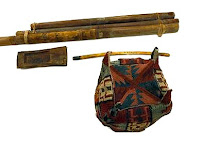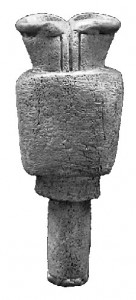 |
| Snuffing kit from Tiwanaku |
We talked here about the use of snuffing tablets and snuffing kits among the ancient Tiwanaku in the Andes, such as the elaborate kit, shown at the right, that was buried with an adult male who appeared to have snuffing lesions near his nose.
A recent archeological discovery, to be published in a forthcoming issue of the Journal of Archaeological Science, now suggests that such South American snuffing devices were considered valuable heirlooms, and were carried long distances and preserved for long periods of time. The study, headed by Scott Fitzpatrick, an assistant professor of anthropology at North Carolina State University, describes three ceramic snuffing bowls found on the island of Carriacou, near Grenada in the Antilles, including the one shown below, which were probably used to snuff hallucinogens, liquid or powdered, through the nose.
 |
| Snuffing tube from Carriacou |
These Caribbean islands were colonized from South America about 400 A.D. Using a type of radioactive isotope analysis called luminescence, the snuffing bowls were dated to between roughly 400 and 100 B.C. — that is, somewhere between five and eight centuries before they were carried to the islands by migrants from South America. Petrographic analysis of the mineral content of the bowls indicated that they were not made using local materials, and thus were probably not manufactured on Carriacou. So the bowls must have come from elsewhere, perhaps Puerto Rico, 465 miles away, where other bowls of similar antiquity have been discovered.
Unlike the Tiwanaku snuffing kits, the bowls were not buried as grave goods. One of the snuffing bowls was found at the site of Grand Bay on Carriacou, in deposits dating between about 1000 and 1200 A.D. Two others were from the local museum. Ceramic snuffing tubes and inhaling bowls used for ingesting hallucinogenic substances are known from several islands in the West Indies, but their chronological distribution is often vague. The Carriacou bowls must have been kept and maintained for at least eight centuries, and they “appear to have been transported to Carriacou when it was colonized — possibly hundreds of years after they were made,” Fitzpatrick said.
Scholars have long thought that the people who settled the Caribbean islands from South America likely brought heirlooms with them, Fitzpatrick said. “The bowls are the first physical evidence we’ve found to support that claim.” According to Fitzpatrick, the bowls not only shed new light on how long humans have been using inhaled hallucinogens, but are “the first physical evidence” to show that the people who colonized the Caribbean from South America brought their heirloom inhalation devices with them.
Descriptions of the study and its findings are found in National Geographic, Practicing Anthropology, and Archeology Daily.
Alas, no chemical analysis was done to determine what substance had been used in the recovered snuffing bowls. And, of course, we have no idea under what circumstances the snuffing bowls were used. But clearly they were important enough to be preserved, carried by boat from South America to the Caribbean, and passed on for centuries.

- Previous Post: The Single Active Molecule
- Next Post: An Experiential Typology of Sacred Plants
- More Articles Related to: Indigenous Culture, Sacred Plants


